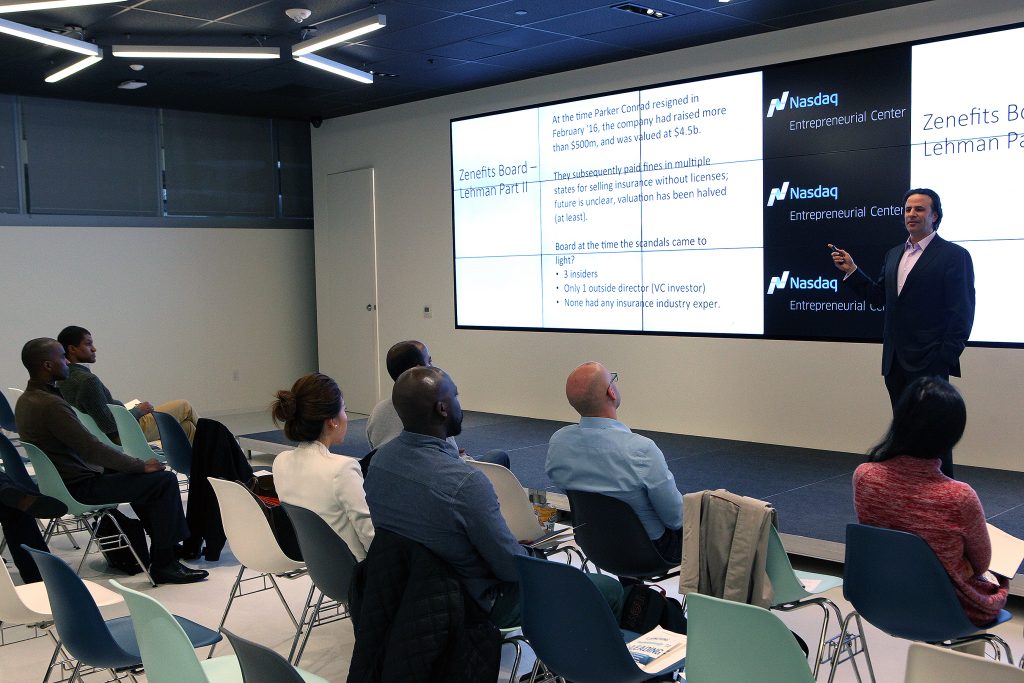A former buy-side colleague astutely summed up the difference between the issues of large-cap and small-cap boardrooms recently when he said: “Large-cap governance dialogue is subsumed by issues like executive compensation and proxy advisors, but against that backdrop it’s easy to forget that most public companies—small caps—and their long-biased investors don’t care much about either.”
What he meant is that proxy advisors don’t issue reports on the majority of public companies, and there are dozens of more impactful issues affecting the success of most small-cap companies than executive compensation. Unlike larger public companies, most pre-initial public offering (IPO) and small-cap companies are more concerned on a daily basis with surviving, not thriving. If you are a director of one of the thousands of smaller public companies or soon-to-be-public companies that lack robust cash flow and healthy balance sheets, you must navigate a treacherous path between solvency and lights out.

When you add in the fact that smaller high-growth companies are often operated by first-time CEOs and governed by novice board members, it becomes increasingly clear that “entrepreneurial governance” is the most accurate label to describe these boards and how they function. It’s a pithy turn of phrase that became the namesake of the column I have written for this publication since 2012. Over the years, the following four subjects have been the source of repeated questions from small-cap-focused readers. All the more reason to devote a few words to each of them.
Trading Volume
A Fortune 1000 board member was correct in one sense when he confidently stated at a corporate governance continuing education program I attended in 2009 that trading volume isn’t a governance issue: it’s definitely not a governance issue for most mid- and large-cap companies that have stocks that trade dozens, if not hundreds of millions of dollars, per day. For some perspective, there are hundreds of public companies in the United States that have stocks that don’t trade more than $200,000 per day.
To make matters worse, diminished trading volume in the small-cap ecosystem has become widespread since the financial crisis. The illiquidity that plagues smaller public companies has several underappreciated, insidious effects on those companies. Most companies that are contemplating a public offering equate being public with having access to capital. But for those companies with stocks that trade infrequently, access to capital can be severely diminished, if not foreclosed. Trading volume is tantamount to alternatives, and at some point, every high-growth company needs as many alternatives as it can get.
Most institutional investors can’t cost-effectively purchase positions in stocks that don’t trade at least $250,000 per day. Hence the reason why most public companies are traded and owned predominantly by retail (i.e., non-professional) investors. While there is nothing inherently wrong with retail ownership, the markets for those stocks tend to be more volatile and less efficient.
If institutional investors can’t purchase stock in a company, the company will never receive high-quality equity research coverage, because analysts and institutional salespeople at investment banks are compensated in part by trading volume arising out of their research recommendations to institutional investors. Only a small percentage of small-cap board members understand that access to quality equity research coverage—and the more efficient markets associated therewith—is directly linked to trading volume. Analysts may love your company, but if it’s not sufficiently liquid they simply can’t make any money recommending it.
Lack of liquidity affects a company’s ability to use its stock as currency for acquisitions. In other words, why would a potential acquisition target accept your company’s stock as consideration if they can never monetize it? The short answer? They won’t.
Stocks that lack trading volume are typically more volatile, that is, they are subject to dramatic price swings with comparatively small amounts of buying and selling. Rapid stock movements understandably give shareholders, employees, and other stakeholders pause.
So what are the key takeaways for entrepreneurial board members? Four principal points:
- Data proves that it’s a potentially fatal mistake for pre-IPO companies to assume that their stock will have a liquid market on a national exchange.
- Most small-cap boards need to treat trading volume as a key enterprise risk.
- For many small-cap companies that regularly require growth capital, increasing their trading volume isn’t just about risk management. It’s also about treating liquidity as a strategic imperative.
- There aren’t any shortcuts to greater liquidity. Trading volume is the result of underpromising and overdelivering, artful storytelling, and engaging with an audience that has shown a proclivity to invest in companies like yours.
Shareholder Activism
If all you read is The Wall Street Journal or listen to is CNBC, you might think shareholder activism is a large-cap phenomenon, and that the only activist investors are Bill Ackman, Carl Icahn, and Nelson Peltz. With deference to top-tier business media, this is fiction.
In actuality, the preponderance of shareholder activism is in small-cap companies. On a recent webinar, iconic small-cap activist defense lawyer Keith Gottfried opined that at least 80 percent of activist campaigns in the United States are in small-cap companies—and possibly more. Why is that the case? First, it’s a lot cheaper to buy 5 percent of a $200 million company than 5 percent of a $200 billion company. Second, small-cap companies typically lack the resources and boardroom experience to persuasively fight back. And third, corporate governance in smaller public companies isn’t so great.
Activism isn’t only on the minds of small-cap board members; it’s also on the minds of pre-IPO companies. In 2017, the median post-money market capitalization of all companies that transacted IPOs in the U.S. was only $486 million, according to EY. In other words, most companies that transact IPOs aren’t multibillion-dollar behemoths; they are barely large enough to be considered small-caps.
Here are some issues that smart pre-IPO and small-cap board members should focus on to reduce the chances of an activist situation.
■ While the basis for staggered boards can sometimes be intellectually sound, they are anathema to activists.
■ Particularly if your company is underperforming compared to its peers, be keen students of how much your company’s officers and directors are being compensated versus the better performers (i.e., performing worse combined with higher salaries is a recipe for activist attention).
■ Don’t outsource your proxy to lawyers. Proxies are legal documents, but they also tell stories. Smart boards understand that proxies are the one opportunity each year to explain in plain English what the board is doing and why. A great proxy won’t necessarily inoculate a company from activist attention, but a formulaic, lawyerly one can make it much more likely.
■ When officers and directors believe their company’s stock is undervalued, they should take action and buy the stock in the open market.
■ Implement stock ownership guidelines so officers and directors have to own some percentage of their annual compensation in stock, and make sure you communicate those guidelines to investors.
■ Every company has a handful of key strategic imperatives, a handful of key impediments to achieving those goals, and key customers and stakeholders. If your board members’ backgrounds don’t map to those goals, risks, and customers, you’re going to have a hard time explaining to activists why you have the right board members.
■ If there are directors who have been on your board for more than 10 years, you need to have frank conversations about refreshment. If you don’t, the activists might end up doing this exercise for you.
■ With the amount of capital under management and small-cap companies overwhelmingly the targets of activists, the days of small-cap boards comprised exclusively of the CEO’s buddies are coming to an end. If that describes your board, consider getting ahead of the curve.
If activists do show up, do your company and its stakeholders a big favor and really listen to what they have to say. Sometimes activists are right. Sometimes they are right but for the wrong reasons. Sometimes they are a combination of shortsighted and dead wrong. You’re never going to know if you don’t listen. Ignoring activists is both common in the small-cap ecosystem and a really bad idea: activists rarely show up for no reason, and they are definitely not going away once they do show up.
D&O Insurance and Indemnification
At larger public companies, incoming board members need not worry about the quality or quantity of directors and officers (D&O) insurance. Moreover, the director indemnification agreements are thoroughly vetted by large law firms and are backed by multibillion-dollar balance sheets. It’s an enormous mistake for newly appointed small-cap board members to assume any of the foregoing.
Given the heightened risks associated with insuring diminutive public companies, the quality of D&O policies available to small-cap boardrooms is highly disparate. As an incoming board member, it’s a great idea to find a securities defense litigator to review the quality of the policy and the construct of the underwriter stack (if relevant). Attorneys who defend officers and directors in securities litigation get paid predominantly by D&O carriers, so they are often the best sources of information about carriers and policies.
When it comes to indemnification agreements, it’s certainly helpful to have your own counsel review the terms. But too many prospective members of small-cap boardrooms omit a salient fact from their reviews. That is, indemnifications are only worth the assets underlying them. Put differently, the very fact patterns that give rise to director indemnification in small-cap companies can materially erode the assets underlying the indemnification.
Dual-Class Companies
Within the Sand Hill Road community of venture-backed companies, it’s becoming more and more common to see controlled companies—in other words, companies where CEOs contractually ensure their absolute control over the company through special classes of stock.
While academics and governance experts have volleyed back and forth angrily about this subject for years, it’s easy to understand why founders with sufficient leverage choose that path. By contractually obviating their own ouster, these CEOs nullify the impact of characteristically imperious venture capitalists and other investors who might be conflicted by shorter-term investment horizons.
But lost in all the hyperbole about dual-class companies is a question that never seems to be asked of prospective independent board members in those companies: Why would you want to be on the board of a company where you’re contractually foreclosed from, you know, governing? The universe of potential answers isn’t extensive: the stock could be worth a lot, it’s accretive to one’s resume, and there could be networking benefits to serving on a board with other well-known people.
No matter how you slice it, being an independent director on the board of a dual-class company is somewhat akin to being a lifeguard who isn’t allowed to go into the pool. There certainly weren’t many lifeguards in the pools of Uber Technologies, Theranos, and Zenefits. It’s only a matter of time until investors—post-IPO—start asking that question. Perhaps by then there will be more compelling answers.
Risks & Rewards
Truth be told, while the responsibilities of the director of a small-cap company do not differ materially from those of a large-cap company director, their worlds are completely different. The combination of frail operating margins and sometimes less experienced officers and directors often requires directors in small-cap boardrooms to get right up against the line that separates operations from oversight. In other words, small-cap board members who don’t have both hands firmly on the wheel at all times can quickly lose control.
Smaller companies are risky, and the chances of reputational damage are commensurately higher. That said, given the tremendous impact a small-cap director can have on a company, and the challenge of navigating a seemingly never-ending continuum of potentially company-killing risks, it’s no wonder that so many small-cap board members say it’s the best job they’ve ever had.
A version of this article originally appeared as the cover story in the May/June 2018 edition of Directorship Magazine.
________________



